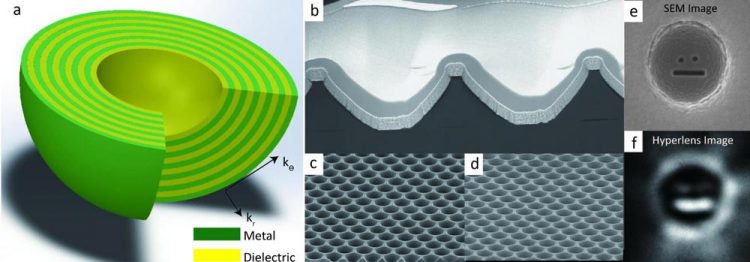Nanoimprinted hyperlens array: Paving the way for practical super-resolution imaging

a) This is a multilayered spherical hyperlens structure. Metal and dielectric thin films are deposited on a spherical shape of substrate. b) This is a transmission electron microscopy (TEM) image of the cross-section of a replicated hyperlens c & d) Tilted view for the quartz master mold and the replicated substrate e) Scanning electron microscopy (SEM) image of the sub-diffraction scale objects. f) Far-field optical image after hyperlens. The small object below diffraction limit is clearly resolved by the hyperlens. Image provided by POSTECH
In 2000, Professor Sir John B. Pendry of Imperial College London — the John Pendry who enticed millions of Harry Potter fans around the world with the possibility of a real Invisibility Cloak — suggested a method of creating a lens with a theoretically perfect focus.
The resolution of any optical imaging system has a maximum limit due to diffraction but Pendry's theoretic perfect lens would be crafted from metamaterials (materials engineered to have properties not found in nature) to go beyond the diffraction limit of conventional lenses. Overcoming this resolution limit of conventional optics could propel optical imaging science and technology into realms once only dreamt by common Muggles.
Scientists all over the world have since endeavored to achieve super-resolution imaging that capture the finest of details contained in evanescent waves that would otherwise be lost with conventional lenses. Hyperlenses are super-resolution devices that transform scattered evanescent waves into propagating waves to project the image into the far-field.
Recent experiments that focus on a single hyperlens made from an anisotropic metamaterial with a hyperbolic dispersion have demonstrated far-field sub-diffraction imaging in real time. However, such devices are limited by an extremely small observation area which consequently require precise positioning of the subject. A hyperlens array has been considered to be a solution, but fabrication of such an array would be extremely difficult and prohibitively expensive with existing nanofabrication technologies.
Research conducted by Professor Junsuk Rho's team from the Department of Mechanical Engineering and the Department of Chemical Engineering at Pohang University of Science and Technology in collaboration with research team from Korea University has made great contributions to overcoming this obstacle by demonstrating a scalable and reliable fabrication process of a large scale hyperlens device based on direct pattern transfer techniques. This achievement has been published in the world-renowned Scientific Reports.
The team solved the main limitations of previous fabrication methods of hyperlens devices through nanoimprint lithography. Based on a simple pattern transfer process, the team was able to readily fabricate a perfect large-scale hyperlens device on a replicated hexagonal array of hemisphere substrate directly printed and pattern-transferred from the master mold, followed by metal-dielectric multilayer deposition by electron beam evaporation. This 5 cm x 5 cm hyperlens array has been demonstrated to resolve sub-diffraction features down to 160 nm under a 410 nm wavelength visible light.
Professor Rho anticipates that the research team's new cost-effective fabrication method can be used to proliferate practical far-field and real-time super-resolution imaging devices that can be widely used in optics, biology, medical science, nanotechnology, and other related interdisciplinary fields.
###
This research was supported by the National Research Foundation of Korea (NRF) grants of Young Investigator program, Engineering Research Center program, Global Frontier program, Pioneer Research program, and the Commercialization Promotion Agency for R&D Outcomes (COMPA) grant, all funded by the Ministry of Science, ICT and Future Planning (MSIP) of the Korean government.
Media Contact
Ms. YunMee Jung
ymjung@postech.ac.kr
82-542-792-417
Media Contact
All latest news from the category: Materials Sciences
Materials management deals with the research, development, manufacturing and processing of raw and industrial materials. Key aspects here are biological and medical issues, which play an increasingly important role in this field.
innovations-report offers in-depth articles related to the development and application of materials and the structure and properties of new materials.
Newest articles

Hyperspectral imaging lidar system achieves remote plastic identification
New technology could remotely identify various types of plastics, offering a valuable tool for future monitoring and analysis of oceanic plastic pollution. Researchers have developed a new hyperspectral Raman imaging…

SwRI awarded $26 million to develop NOAA magnetometers
SW-MAG data will help NOAA predict, mitigate the effects of space weather. NASA and the National Oceanic and Atmospheric Administration (NOAA) recently awarded Southwest Research Institute a $26 million contract…

Protein that helps cancer cells dodge CAR T cell therapy
Discovery could lead to new treatments for blood cancer patients currently facing limited options. Scientists at City of Hope®, one of the largest and most advanced cancer research and treatment…



